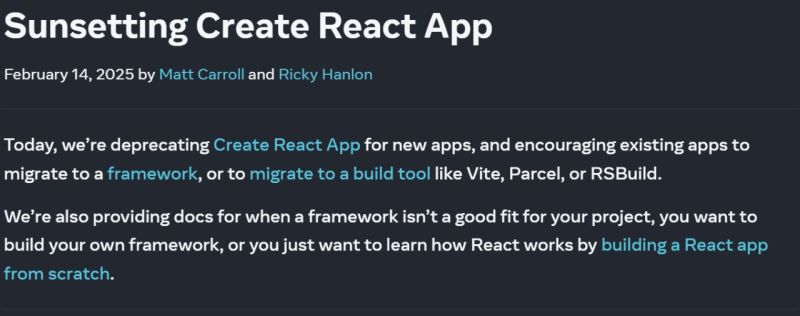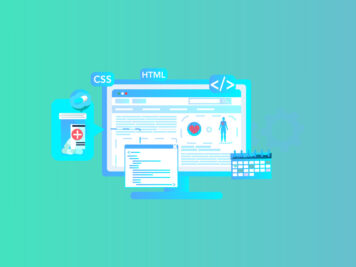Remember the days when React projects began with a simple: “npx create-react-app my-app”
Ah, the classic start to a React project. For years, Create React App (CRA) was the go-to way to get up and running—handling Webpack, Babel, and other complex tooling under the hood. According to Netlify, CRA was utilized by 27% of their users compared to all other frontend frameworks. Given that this statistic comes from just one platform, it’s likely that its usage was even higher across the broader ecosystem.
Beyond its popularity, CRA was also the officially recommended way to build single-page React applications. But the front-end world moves fast, and CRA has now been officially sunset due to limitations like poor code splitting, data fetching, and routing.

So, what’s next?
Many developers wonder, Will React fade? How do we now create a new react app? How will I decide what is better for my project?
Good news—React is thriving. The CRA (Create React App) site now recommends switching to a framework or build tool. But with so many choices (Next.js, Vite, Expo, React Router, Rsbuild, Parcel), it is easy to feel lost in decision fatigue. That’s why I have put this guide together, to help you simplify that decision. You’ll learn when to use a full framework or a lighter builder, with clear comparisons and real-world insights. By the end, you’ll know exactly which tool fits your project—and how to build smarter, faster react application.
Do you need a framework or just a builder?
First thing first, before you start, decide whether to go with framework or a builder. To make this decision, ask yourself these core questions.
What’s the scale of your app?
If it’s a small or static project, use a builder. For complex apps that require built-in routing, data fetching, or authentication, use a framework.
How you want to configure the functionalities of the project?
If you want an opinionated one with built-in features like navigation and data handling, go with a framework. But if you prefer to choose these features yourself by adding them later, use builder.
How important is a shallow learning curve and fast implementation?
If you need to become productive quickly or train junior developers, choose tools with simpler models like Vite or Parcel.
What tools does your team already know?
Don’t overcomplicate it. A familiar builder could save time compared to adopting a complex framework with a steep learning curve.
You are just a beginner and trying to learn React?
If you are just trying to explore React or want to learn from scratch, I recommend you start with builders.
Which framework: Next.js vs React Router vs Expo?
Between Framework and Builder, if you’ve decided to move forward with a framework, let me help you choose the right one for your project. Refer to the table below to compare features and decide which one suits you.
| Feature | Next.js | React Router | Expo |
| Primary Use | Web + Integrated Backend | Frontend Routing Only | Mobile-First + Limited Backend |
| Target Platform | Web Browsers, Node.js Server | Web Browsers | iOS, Android, Web |
| Backend Capabilities | Integrated API Routes | No | No (can integrate with web support) |
| Build & Deployment | Optimized build process, deployment to various platforms (Vercel, Netlify, etc.) | Standard web build process (Create React App, Vite, etc.) | Expo CLI for building and EAS for build/deployment |
| Development Workflow | Opinionated structure, excellent developer experience | Flexible, integrates into existing React setups | Managed workflow, Expo Go for rapid development |
| Key Strengths | Versatile rendering, large ecosystem, backend in the same project, performance optimizations | Declarative routing, nested routes, dynamic matching, client-side navigation | Simplified native development, rich SDK, OTA updates, cross-platform codebase |
| Best For | Complex full-stack web applications Ex:- E-commerce, SEO-heavy app | SPA with dynamic navigation | Cross-platform native mobile apps |
Key findings
You can go with Next.js for building complete websites that are fast and good for search engines, even handling the website’s backend. Whereas with React Router for making navigation smooth within single-page applications. And Expo to build apps that work on both iPhones and Android, and it can even help create a basic web version.
Which builder: Vite, Parcel, Rsbuild, Webpack?
If you don’t need a framework, a builder gives you a customizable starting point. But which one?
Let us compare builders i.e. Vite, Rsbuild, Parcel and Webpack based on decisive functionalities.
1. Build performance
| Builder | Dev Speed | Build Speed | HMR Support |
| Vite | ⭐⭐⭐⭐⭐ (fastest dev) | Fast (uses Rollup) | Instant HMR |
| Rsbuild | Very Fast | Optimized for Production Builds | Fast & Reliable with Fine-grained Control |
| Parcel | Fast (zero config) | Competitive | Strong |
| Webpack | Slower in large apps | Slower | Reliable but heavier |
2. Plugin ecosystem and configurability
| Builder | Configurability | Plugin Support and Eco System |
| Vite | Clean vite.config.js | Growing fast, 1,000+ plugins |
| Rsbuild | (Assumption: Flexible) | Growing |
| Parcel | Zero-config | Solid |
| Webpack | Powerful, complex | Thousands |
3. Docs, community, stability
| Builder | Docs | Community | Stability |
| Vite | Great | Growing fast | Backed by Vue team |
| Rsbuild | Good | Growing | Actively Developed |
| Webpack | Huge archive | Mature | Long-term leader |
| Parcel | Good | Dev-friendly | Reliable for simple apps |
4. Let’s dive into some statistics of JS:
- Webpack: Lower satisfaction compared to newer tools, but still widely used.
- Parcel: Generally good satisfaction, praised for ease of use.
- Vite: High Retention rate (likely 98% based on surveys), strong growth.
- Rsbuild : Relatively newer, gaining traction, satisfaction data might be emerging.
(Above data is as per Survey of JS 2024 results: – https://2024.stateofjs.com/en-US/libraries/)
Key findings
- Use Vite if you want speed, simplicity, and a large plugin ecosystem. It’s the most popular modern builder.
- Use Rsbuild if you’re focused on optimized production builds with more control.
- Use Parcel for quick setup and small-to-mid projects with minimal config.
- Use Webpack only if you’re maintaining a legacy app or need deep custom configuration.
Conclusion
CRA may be gone, but React’s ecosystem is more powerful than ever.
Thus, from above all data and my expertise of working and building react application using framework as well as builder I would recommend, if you’re building modern, scalable, and SEO-friendly web apps, Next.js is hands-down the best choice. For blazing-fast development and flexibility without unnecessary bloat, Vite is my go-to builder. Want to build native mobile apps using React? Expo is unbeatable in simplicity and power.
I would say whether you’re opting all-in on frameworks or prefer the flexibility of builders—there’s a perfect tool for your next react project. Pick smart, build fast, and ship confidently.
Here comes a final check list that helps you choose between framework and Builder: –
| Use Case | Recommended Tool |
| Full-stack Web Apps | Next.js |
| Fast Development (Modern Web) | Vite |
| Cross-Platform Mobile + Web Apps | Expo |
| Highly Optimized Production Builds | Rsbuild |
| Client-side Routed SPA | React Router |
| Quick Zero-Config Prototyping | Parcel |
References
https://2024.stateofjs.com/en-US
https://survey.stackoverflow.co
https://react.dev/blog/2025/02/14/sunsetting-create-react-app
https://legacy.reactjs.org/blog/2016/07/22/create-apps-with-no-configuration.html


 " class="img-responsive width-100 featured-img mar-b-5" loading="lazy" />
" class="img-responsive width-100 featured-img mar-b-5" loading="lazy" />







